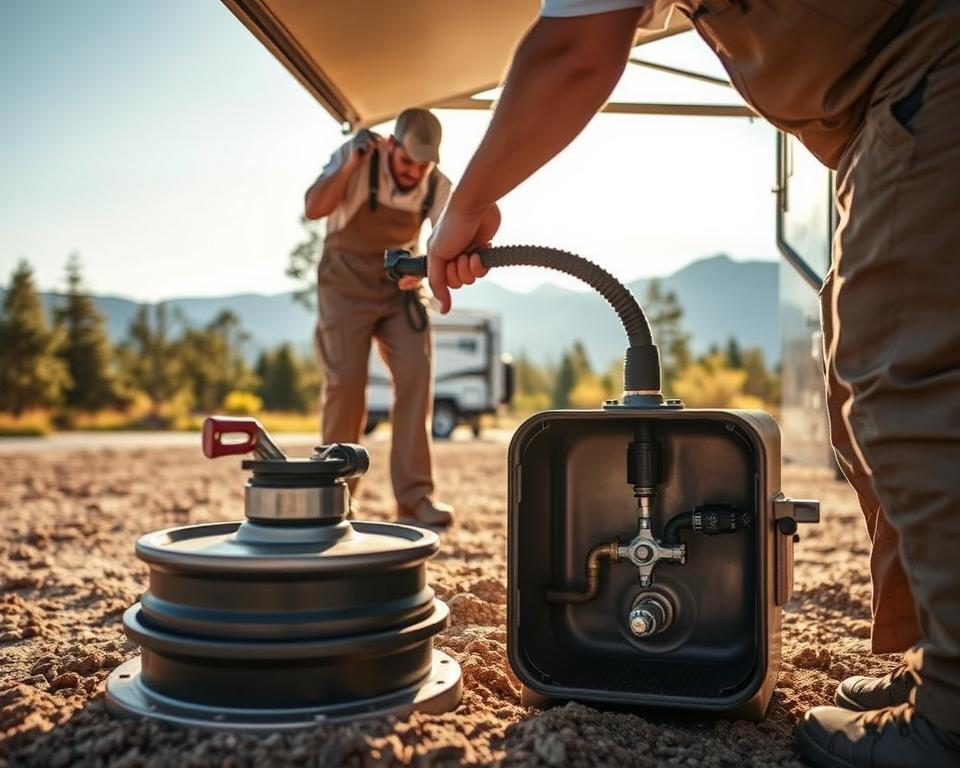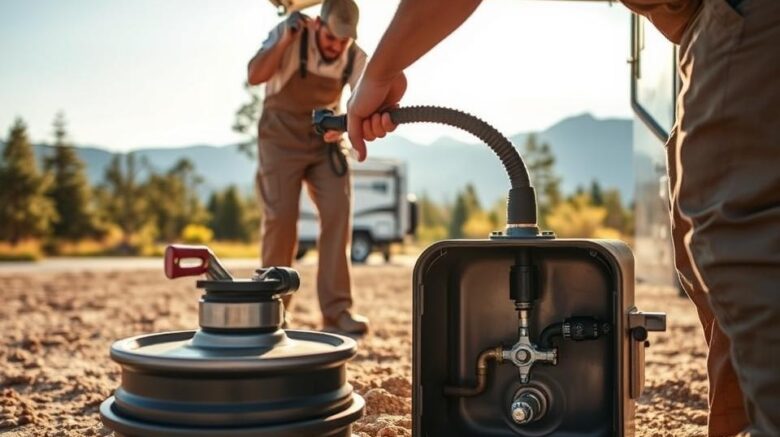RV Water Tank & Pump: Ultimate Guide
Ever thought how seasoned RVers ensure perfect water flow while touring? It’s chiefly due to your RV water Tank & Pump. From heading to national parks or a simple weekend retreat, commanding your RV’s water system is vital. This article we explore the must-knows: the elements, upkeep, and strategies for smooth travel. Grasping each component, from the linework to Tank filling, ensures water is always on tap during your outings – RV waste water pump.
Vital Observations
- Getting familiar with the RV water system optimises your travel experience.
- The RV fresh-water Tank & Pump are central for a reliable water supply.
- Consistent upkeep extends the lifespan of your RV plumbing.
- Knowing how to fill your Tank properly can forestall future issues.
- Fixing your water Pump can save you from unexpected problems.
Demystifying RV Water Systems
RV water systems consist of two principal parts: the fresh-water setup and the grey/black-water mechanism. The clean-water circuit includes several core components like the storage Tank, pressure Pump, and faucets, mirroring home plumbing while catering to the ever-changing needs of living on the move.
Supplying clean water is non-negotiable for the system’s performance. It protects the health of all passengers. It’s vital to keep the RV plumbing in prime condition through scheduled maintenance – including proper drainage to prevent leaks and other issues. Timely inspections help RV enthusiasts dodge water-related surprises during their journeys.

Why You Need the RV Water Tank
The RV water Tank is pivotal for a smooth journey. It stores the fresh water needed for drinking, cooking, and cleaning. The capacity of this container changes with each RV model, affecting how much water can be stored – and directly dictates how long you can travel before needing a refill.
Ensuring the RV water Tank clean is essential. Routine cleaning wards off harmful contaminants, so the water remains safe for use. Ignoring maintenance can cause bacteria or algae growth, making the water hazardous.
Recognising the RV water Tank’s role streamlines water management during trips. Proper upkeep and frequent refills ensure a worry-free experience. It’s key to have ample water for all travel needs, guaranteeing a trouble-free RV adventure.
How to Fill Your RV Water Tank
Filling your RV water Tank demands attentive action to guarantee it’s done correctly. There are two main methods: gravity-feed filling and pressure filling. Perfecting these techniques significantly improves your RV conditions.
Gravity filling is direct. You just need a drink-safe water hose. Hook up this hose to a water source, then to the fill opening, and let gravity handle the fill. Always watch the water level to avoid spills.
Pressure filling involves a city water connection, which is faster delivery. You must use a pressure regulator to manage water flow. Connect the hose from the municipal source to your RV. This method provides quick and consistent supply to your reservoir.
Choosing approach you use, adhere to these key safety tips: Always monitor the fill when filling to prevent overflow, and use clean water to avoid health issues. Mastering these filling and safety techniques will render your RV trips even more enjoyable.
RV Water Tank and Pump: Core Elements Unpacked
The RV water Tank and Pump are crucial to any RV’s plumbing system, providing a consistent and dependable water supply for all your needs. The RV water Pump’s main job is to move water from the Tank, so clean water is always ready. That’s critical for cooking, cleaning, and showering.
RV plumbing utilises different Pump types, each with individual benefits. Diaphragm pumps are prized for their steady water pressure, while centrifugal pumps are loved for mechanical simplicity and energy thrift. It’s essential to weigh flow rate, noise, and installation ease when picking your Pump.
To conclude, the RV water Tank and Pump are indispensable to your water system’s functioning. A dependable Pump guarantees strong pressure and smooth flow, improving your overall travel experience.
Selecting the Right RV Water Pump
Finding the correct RV water Pump is key for your plumbing’s peak performance. When picking a Pump, considering a few points is critical for a great camping experience. Ensuring it fits your RV’s water system is paramount.
Keep these primary aspects in mind:
- Flow Rate: Select a Pump with a flow rate that meets your usage needs. A stronger flow means faster Tank refills.
- Pressure Ratings: Your RV’s different fixtures set the needed pressure levels. Go with a Pump whose specs match those needs for smooth operation.
- Noise Levels: Noise can be an issue with some Pumps. For a calm cabin, contrast models for their noise output.
Brands like Shurflo and VEVOR are favourites for many RVers, and they offer distinct advantages. A careful assessment of these brands will assist your decision-making process.
Understanding these factors is not only important for the right purchase but also arms DIY enthusiasts with key know-how for upkeep and replacements.
Hooking Up to City Water for Your RV
Hooking your RV to city water provides an effortless supply of fresh water, moving you beyond just using your Tank. This guarantees a more comfortable camping experience. Make sure to follow specific steps for a secure hookup.
First, identify the city water connection port on your RV. It’s often marked by a bright or black connector, sometimes tagged for ease. Grab a potable water hose rated for RVs; this kind of hose protects your water safe from contaminants.
It’s essential to attach a pressure regulator before making the connection. This fitting shields your plumbing by controlling the water pressure. With the regulator in place, connect the hose from it to the water source.
Once connected, watch the water pressure. Aim for a steady, gentle flow to avoid hose damage. Inspect your hoses regularly for any wear or leaks and quickly replace parts as needed.
Adhering to these steps for city hookup boosts your camping convenience and helps in maintaining your RV’s condition.
Caring for Your RV Water Tank
Keeping your RV’s water Tank is well cared for is essential for fresh, healthy water while travelling. A sound Tank avoids bacterial growth and contamination. For starters, periodically sanitise the Tank: combine water with a bit of bleach for an efficient residue-free clean.
It’s crucial to look for leaks and control Tank pressure. Regular checks can detect problems early, sparing expensive fixes. A consistent regimen maintains the water system in prime condition.
For optimal maintenance, create a checklist:
- Check water levels and quality often.
- Sanitise the Tank twice a year with a bleach solution.
- Inspect for leaks in the reservoir.
- Monitor Tank pressure and Pump function.
- Flush the Tank to clear any sediment buildup.
RV Water Pump Troubleshooting
RV water Pump troubles can be annoying, disrupting travel plans unexpectedly. Facing strange noises, dealing with low pressure, or suffering complete Pump failure are common problems. Knowing how to troubleshoot these issues can significantly improve your trips.
If you hear odd sounds from your Pump is usually a problem. Start is to check for loose connections and secure them. When there’s low water pressure, checking hoses and fittings for leaks. Even a small leak can dramatically affect flow, early troubleshooting is critical.
If your Pump stops completely, check electrical connections. Begin by examining the Pump’s fuse. If the fuse is fine, dig deeper for wear or damage.
A step-by-step approach identifies and rectifies water system issues. Routine maintenance and inspection guarantee easier journeys.
| Issue | Possible Cause | Suggested Solution |
|---|---|---|
| Strange Noises | Loose connections | Tighten fittings |
| Low Pressure | Leaky hoses/fittings | Find & seal leaks |
| Pump Failure | Electrical fault | Check fuse/wiring |
| No Water Flow | Blocked lines | Flush obstructions |
Tips for Efficient RV Water Use
Boondocking in remote areas typically entails limited water access. Wise use in your RV is vital. By adopting smart conservation tactics, you don’t just manage resources well but also boost camping satisfaction.
To make the most of water while travelling, try these tips:
- Take brief showers – aim for under five minutes.
- Install water-saving fixtures like low-flow showerheads and faucets.
- Reuse grey water: dishwater can flush toilets or water plants.
- Monitor reservoir levels regularly to avoid overflow.
- Plan water stops in advance: know filling stations along your route.
In Closing
Understanding the nuts and bolts of your RV water systems is crucial to a successful travel adventure. The water Tank & Pump remain at the centre of this, requiring regular upkeep. By maintaining these systems, you ensure a dependable supply and avoid potential snags.
Diligent troubleshooting and checks reduce stress and spare time. Being proactive about upkeep is essential, particularly when you’re miles away from help. Proper care allows you to maximise water use, boosting comfort for everyone.
When you head out, use this guide to command your RV’s water systems. Making informed choices about plumbing and equipment equip you to embrace the freedom of the road. Wishing you joyous and trouble-free travels ahead!
